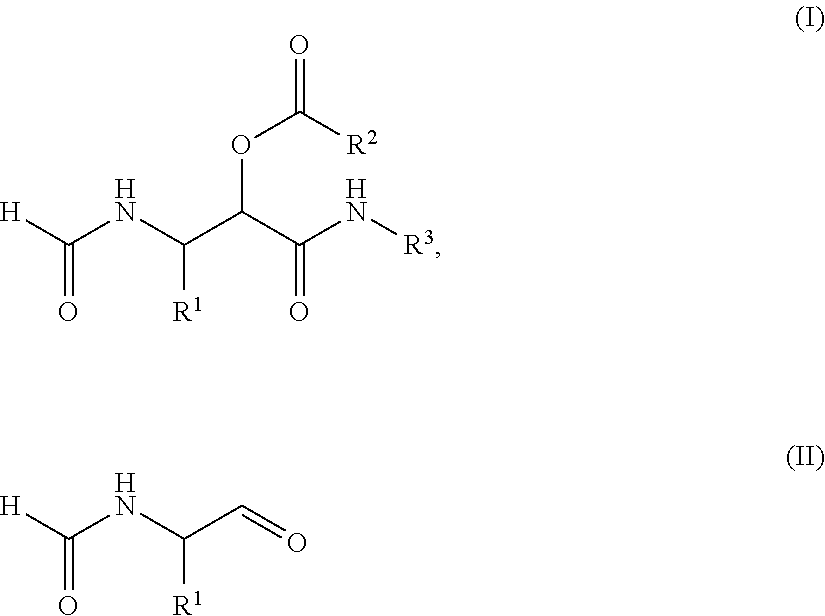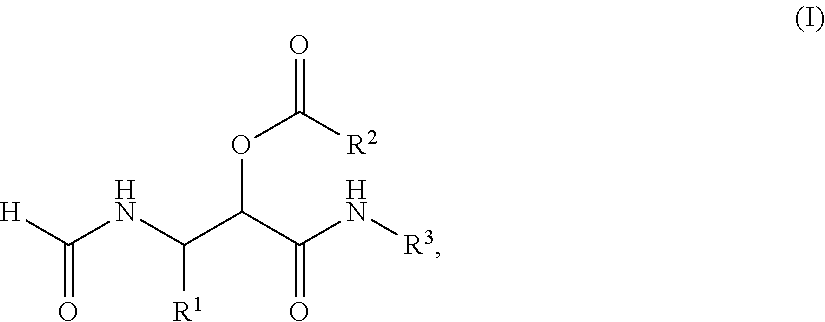Process for the preparation of α-acyloxy β-formamido amides
a technology of acyloxy and -formamido amide, which is applied in the preparation of organic compounds, isocyanic acid derivatives, and transesterification. it can solve the problems of limited yield and variation of the building blocks involved, cumbersome synthesis, and low yield of the disclosed synthesis. it achieves less solvent and manpower, reduces the cost of synthesis, and increases the atomic efficiency of reaction
- Summary
- Abstract
- Description
- Claims
- Application Information
AI Technical Summary
Benefits of technology
Problems solved by technology
Method used
Image
Examples
example 1
Synthesis of (S)-2-Formamidopentanal (1)
[0082]
Compound (I) and its Dimeric Form
[0083]Dess-Martin periodinane (5.514 g, 13 mmol) was added to a solution of (S)-2-formamido-1-pentanol (1.31 g, 10 mmol) in CH2Cl2 (100 ml) at room temperature. The white suspension was stirred for 2 days and subsequently 35 ml MeOH was added and stirred for 30 minutes. The resulting suspension was filtrated and the filtrate was concentrated in vacuo. The crude product was purified by silica gel flash chromatography (cHex:EtOAc=1:4) to give compound I (1.08 g, 8.29 mmol, 83%) as a white solid. NMR analysis indicates that compound I is in equilibrium with its cyclic dimmer, which was found to form a mixture of diastereomers.
[0084][α]D20=+37.6 (c=0.745, CHCl3); 1H NMR assigned to the monomer (250.13 MHz, CDCl3): δ=8.22 (s, 1H), 7.84 (s, 1H), 7.10 (m, 1H), 5.31 (m, 1H), 1.52 (m, 4H), 0.95 (m, 3H); 13C NMR assigned to the monomer (100.61 MHz, CDCl3): 198.8 (CH), 161.7 (CH), 57.4 (CH), 30.8 (CH2), 18.4 (CH2), ...
example 2
Synthesis from Compound I as Obtained in Example 1
[0085]
(3S)-2-acetoxy-N-cyclopropyl-3-formamidohexanoyl amide (3)
[0086]Aldehyde compound I (0.892 g, 6.91 mmol) was added to a solution of cyclopropyl isocyanide (0.410 g, 6.12 mmol) in CH2Cl2 (110 ml) and stirred for 5 minutes at room temperature. Acetic acid (0.711 ml, 0.747 g, 12.44 mmol) was added and the yellow reaction mixture was stirred for 3 days at room temperature. The reaction mixture was washed twice with 100 ml saturated Na2CO3, followed by drying with Na2SO4 and concentration in vacuo. The crude was purified by silica gel flash chromatography (5% MeOH in CH2Cl2, 1% triethylamine). (3S)-2-acetoxy-N-cyclopropyl-3-formamidohexanoyl amide (0.99 g, 3.87 mmol, 56%) was obtained as a white solid as a 78:22 mixture of diastereomers.
example 3
In situ-preparation of (3S)-2-acetoxy-N-cyclopropyl-3-formamidohexanoyl amide (3) without isolation of the compound obtained in example 1
[0087]Dess-Martin periodinane (5.66 g, 12.3 mmol) was added to a solution of (S)—N-(1 hydroxypentan-2-yl)formamide (1.15 g, 8.8 mmol) in CH2Cl2 (12 ml) at room temperature. The white suspension was stirred for 60 minutes and subsequently cyclopropyl isocyanide (0.74 g, 10.0 mmol) was added and stirred for 48 hours. The resulting suspension was filtrated and washed twice with 10 ml saturated Na2CO3, followed by drying with Na2SO4 and concentration in vacuo. The crude product was purified by silica gel flash chromatography (5% MeOH in CH2Cl2, 1% triethylamine) to give compound 3 (1.34 g, 5.22 mmol, 60%) as a pale yellow solid as a 78:22 mixture of diastereomers.
[0088]1H NMR (130° C., 400.13 MHz, DMSO-d6): δ=8.03 (s, 1H), 7.52 (m, 1H), 7.30 (m, 1H), 4.89 (d, J=4.4, 1H), 4.28 (m, 1H), 2.65 (m, 1H), 2.17 (s, 3H), 1.27-1.47 (m, 4H), 0.89 (t, J=7.2, 3H), ...
PUM
| Property | Measurement | Unit |
|---|---|---|
| temperature | aaaaa | aaaaa |
| structure | aaaaa | aaaaa |
| Electrophilic | aaaaa | aaaaa |
Abstract
Description
Claims
Application Information
 Login to View More
Login to View More - R&D
- Intellectual Property
- Life Sciences
- Materials
- Tech Scout
- Unparalleled Data Quality
- Higher Quality Content
- 60% Fewer Hallucinations
Browse by: Latest US Patents, China's latest patents, Technical Efficacy Thesaurus, Application Domain, Technology Topic, Popular Technical Reports.
© 2025 PatSnap. All rights reserved.Legal|Privacy policy|Modern Slavery Act Transparency Statement|Sitemap|About US| Contact US: help@patsnap.com



